The spread of smart devices both in the home and in the industrial setting has made developing Internet of Things hardware a profitable and highly competitive sphere. In this article, Velvetech experts provide a comprehensive guide to everything businesses need to consider before launching an IoT hardware product.
Particularly, we talk about:
- Definitions
- Architecture
- Key Features
- Main Stages of Development
- Benefits of Custom Hardware
- Pitfalls of Poor Design
What Is Internet of Things Hardware?
Internet of Things (IoT) hardware refers to the physical elements and components that are used to connect objects, devices, and systems to the Internet, enabling them to collect, send, and receive data. They typically include sensors, actuators, microcontrollers, communication modules, and other necessary components. Let’s take a closer look at them.
Sensors

These devices detect changes in their physical environment and transmit them to the rest of the system by converting them into electrical signals. Sensor examples include temperature, humidity, motion, light, pressure sensors, and many others. Together with other factors, their reliability is paramount in measuring the environmental impact of your business.
Learn how to leverage your IoT Hardware for Sustainability
Actuators

Actuators are the components that enable IoT devices to perform various actions, based on the instructions they receive. The most common types are motors, servos, valves, and relays. These elements are often remote-controlled and used in spheres like home automation and robotics.
Microcontrollers and Processors
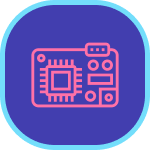
Able to process significant amounts of incoming data, these are the brains of IoT solutions responsible for controlling their operations. Some well-known microcontroller units (MCUs) are Arduino boards, Raspberry Pi, ESP32, and others. Single-board computers (SBCs) are an equally popular choice among developers, who value their robust architecture.
Modules

The modules installed into an IoT device largely define its functionality. Data acquisition modules include the sensors described above and are tasked with getting signals across to the rest of the architecture.
Data processing modules have similar functions to traditional computers and deal with data analysis and local storage. To implement them successfully, it’s important to have a clear image of the amount of information the device is expected to work with.
IoT devices need a way to connect to the internet to send and receive data. Communication modules such as Wi-Fi, Bluetooth, Zigbee, LoRa, Cellular (3G/4G/5G), and RFID facilitate this connectivity and ensure communication with the used cloud solutions. They could be wireless or include such ports as USB or CAN.
Wearables
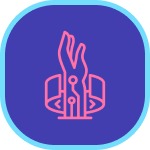
The rise in popularity of wearables like smart watches, fitness trackers, and other monitoring devices made them an essential type of IoT hardware. Connectivity and data gathering are two of their primary functions, as they collect data about the user and communicate it to other devices or platforms.
Smart Home Devices
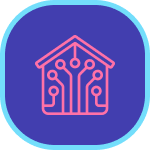
IoT hardware for smart homes unites various appliances and devices that can be controlled remotely and automate various functions. Most prominently, these are smart bulbs, thermostats, locks, and other intelligent solutions.
Industrial IoT (IIoT)
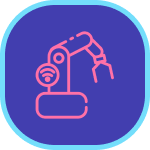
These are applied in industrial settings for monitoring and controlling equipment, optimizing processes, and improving efficiency. Industrial sensors, actuators, and controllers are among the most sought-after IIoT solutions.
Read about the Development of an IIoT Solution for an Engineering Company
Vehicle IoT
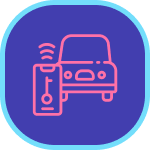
IoT hardware in vehicles includes devices for tracking, diagnostics, navigation, and entertainment systems, such as GPS trackers, OBD-II dongles, and in-car infotainment systems.
Explore the project where Velvetech developed a New Generation of Smart Tires
Healthcare IoT
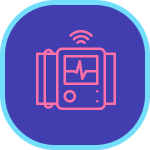
IoT hardware in healthcare incorporates a multitude of technologies: devices for remote patient monitoring, medical imaging, wearable health trackers, smart medical equipment, and more. These play a crucial role in enabling improved efficiency, convenience, and safety for all the participants and healthcare providers.
Learn more about Wearables in Healthcare
IoT Hardware Architecture
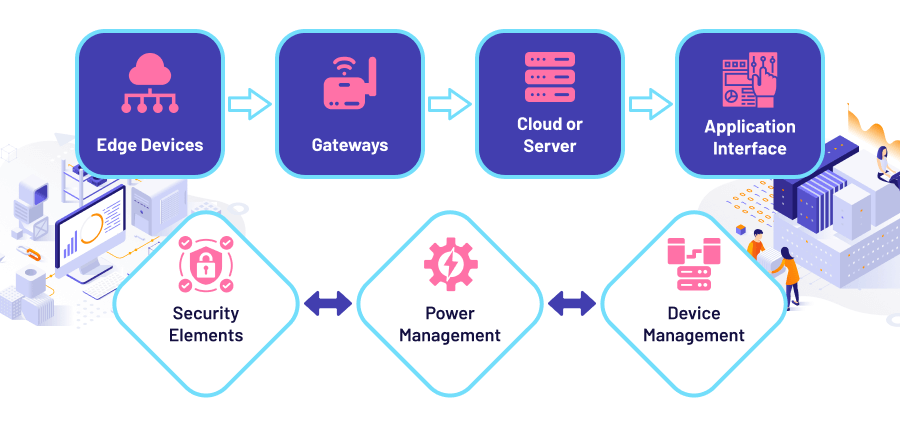
IoT hardware architecture refers to the way the physical components within an IoT system are arranged as a part of a defined structure.
Its design ensures that all the devices, sensors, communication modules, and other hardware parts are interconnected and organized to collect, process, transmit, and act on data.
The architecture can vary significantly depending on the specific use case, requirements, and scale of the IoT deployment. However, there are a number of components typically found in most IoT hardware architectures.
Edge devices are located at the fringe points of the IoT network, where they initially collect data from the physical world. They later transform it into digital form, before transferring it to gateway devices that serve as intermediaries between them and the central data processing systems.
These devices aggregate data from multiple edge sources, perform data preprocessing, and ensure secure communication. Correct gateway application in industrial IoT systems is vital due to high connectivity requirements.
Central data processing happens within a server or cloud infrastructure. Cloud platforms such as Amazon Web Services (AWS), Microsoft Azure, and Google Cloud Platform (GCP) are preferred industry options for many businesses.
Discover how to Optimize Your Cloud Costs
These platforms receive data from the gateway devices, store it securely, and enable advanced analytics, machine learning, and visualization.
As a more modern and performant alternative, edge computing on IoT devices may be used instead of traditional cloud computing. It ensures lower latency rates and quicker data offload with more access points managed in real time.
Security elements are another critical aspect of IoT hardware architecture to protect data, devices, and the overall system from cyber threats. Hardware-based security features such as Trusted Platform Modules (TPM) or Secure Elements also offer IoT systems enhanced protection.
For IoT devices, especially those in remote or battery-operated settings, efficient power management is equally vital for cost-efficiency and productivity. On a hardware level, architectures may include power-saving features, sleep modes, and the use of low-power components, as well as energy-collecting techniques, such as solar panels or kinetic energy harvesting.
IoT hardware architectures often incorporate systems for remote device management and monitoring. These solutions enable administrators to update firmware, configure devices, diagnose issues, and track device health.
Learn more about Embedded Systems in IoT
Finally, application interfaces exist to allow users to interact with IoT devices. Their design varies from mobile apps and web dashboards to interactive panels, which make up a crucial part of the architecture. These interfaces allow users to monitor data, control devices remotely, set up automation rules, and receive alerts or notifications.
What Makes Up Great IoT Hardware
A successful solution exhibits a range of features that contribute to its effective implementation in business and industrial processes. Here are the top characteristics that can make or break it.
Reliability

Reliable IoT hardware is crucial for maintaining continuous operations without frequent failures or downtime. It should be durable, with long lifespans, to withstand various environmental conditions. Redundancy features can be included to ensure failover mechanisms in case of hardware failures.
Scalability

Successful IoT hardware should scale easily as the number of connected devices grows. Due to modularity, these architectures allow for the addition of new devices without significant changes to the system. As a result, scalable hardware enables IoT deployments to expand seamlessly and accommodate increasing data volumes and connections.
Interoperability
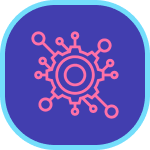
IoT hardware that adheres to industry standards and protocols ensures interoperability with other systems. Compatibility with common communication protocols (e.g., MQTT, CoAP, HTTP) facilitates seamless integration with various IoT platforms and applications. Interoperable hardware allows for easy data exchange and communication between non-uniform devices from different manufacturers.
Robust Security
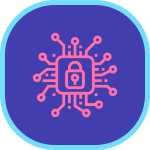
Like in every other sphere, security is the factor to consider while designing IoT hardware to be protected against cyber threats and data breaches. Hardware-based security features such as encryption, authentication mechanisms, and secure boot ensure data integrity and confidentiality. Regular security updates and patches should also address vulnerabilities and maintain a safe environment.
Find out all about IoT Security Issues
Optimized Power Consumption
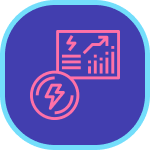
Many IoT devices are battery-powered or operate in remote locations, so optimum power consumption is needed for extended battery life. Energy-efficient hardware design, including low-power components and sleep mode availability, helps conserve energy and prolong device operation.
Data Processing Capabilities
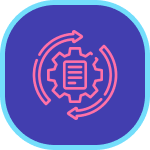
IoT hardware should have sufficient capabilities to handle data processing tasks locally, reducing latency and dependence on cloud services. On-device analytics and edge computing promote real-time operations, analysis, and decision-making at the device level. High-performance processors and memory are prime factors in the efficient execution of algorithms and machine-learning models on the edge.
Unveil the Role of Machine Learning in IoT
Ease of Deployment and Maintenance
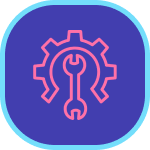
Successful IoT hardware is easy to deploy, configure, and manage, reducing the complexity of setup and ongoing maintenance. Plug-and-play features simplify the installation process, allowing devices to quickly connect to the network and become operational. Remote device management capabilities enable administrators to monitor device health, update firmware, and troubleshoot issues without direct interaction.
Cost-Effectiveness

Cost considerations play a significant role in the success of IoT hardware, especially for large-scale projects. It should provide value for money, with the necessary features and performance at a competitive price point.
Long-term operational costs, including maintenance, upgrades, and energy consumption, are all important considerations. In some situations, they can be offset by design excellence, but in others, they may turn into an unmanageable burden on the system.
Adaptability
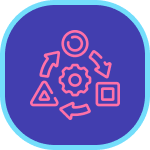
Performant IoT hardware is versatile and adaptable to a wide range of use cases and industries. Modular designs and customizable configurations allow for meeting specific requirements and integrating with diverse applications. Flexibility in hardware capabilities, such as sensor compatibility, communication protocols, and form factors, should support a variety of IoT solutions.
User-Friendly Interface

Intuitive user interfaces, such as mobile apps or web dashboards, enhance the usability of IoT hardware for end-users. Easy-to-understand controls, visualizations, and alerts improve user experience. User feedback and usability testing help refine interfaces to meet the needs of diverse user groups and boost product popularity.
Key Steps in IoT Hardware Development
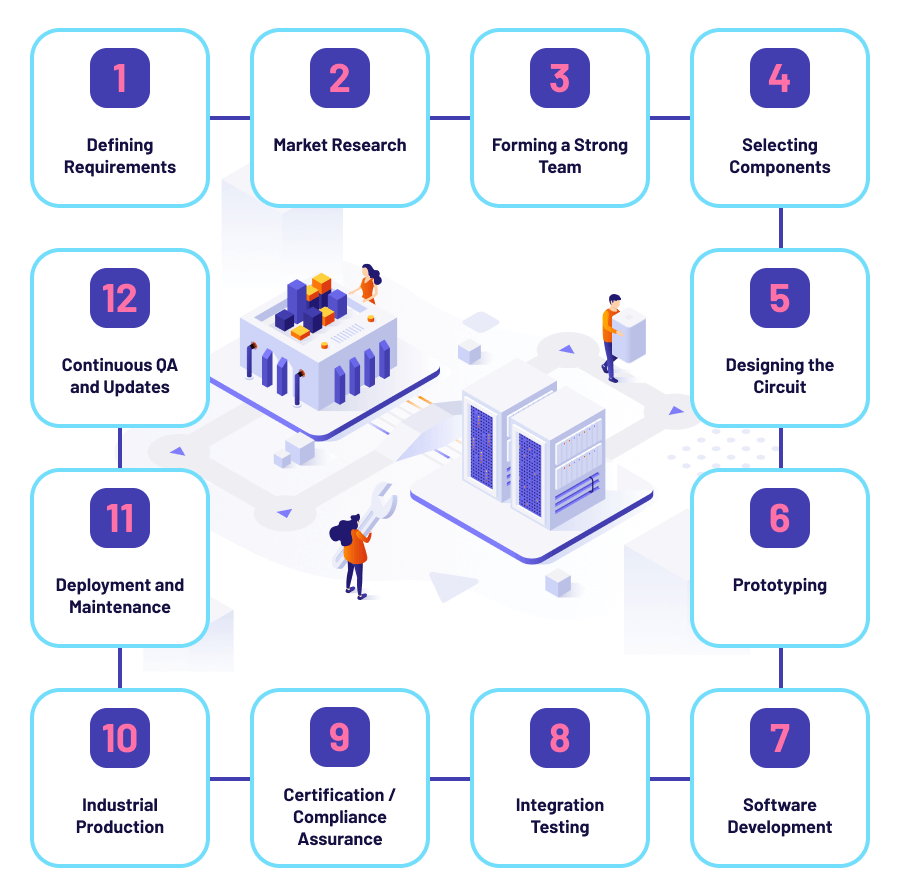
Process management is as important for IoT hardware development as its more technological aspects. By taking into account its main stages and building a structured roadmap, an enterprise can ensure a solid foundation for its product’s success. Let’s look at a brief overview of these essential steps.
Step 1: Defined Requirements
The first step is to clearly define the requirements of the IoT device. This includes understanding its intended use, the environment it will operate in, the data it needs to collect, the type of connectivity required (Wi-Fi, Bluetooth, cellular, etc.), and any specific constraints such as power consumption or size.
Step 2: In-Depth Market Research
Conducting market research is key to understanding the existing solutions, competitors, and potential customers. Evaluate the feasibility of your IoT hardware project, considering technical requirements, costs, regulatory constraints, and market demand for a smooth post-production sales process.
Step 3: A Strong Team
This is a demand applicable to any development project. However, it becomes paramount in IoT hardware development, as it requires a multidisciplinary team with expertise in hardware engineering, software development, data analytics, user experience design, and project management. To reach your business goals faster, ensure clear communication channels and collaboration among team members.
Expanding a Team
Watch our webinar to unveil the tricks of onboarding a tech partner and incorporating it into the process to foster your product delivery.
Step 4: Appropriate Components
Based on the requirements, developers choose the necessary components for the IoT device. This includes microcontrollers or microprocessors, sensors, actuators, communication modules, power sources, and other supporting hardware.
Step 5: Circuit Design
Engineers design the circuit board layout considering factors such as size constraints, power consumption, heat dissipation, and signal integrity. This involves using CAD (Computer-Aided Design) software to create the schematics and layout of the circuit board.
Step 6: Prototyping and Iteration
Once the circuit design is complete, a prototype of the IoT device is built. This involves soldering components onto a circuit board and assembling the device. The prototype allows developers to test the functionality of the device, identify any issues, and make necessary improvements in a step-by-step fashion.
Step 7: Software Development
Alongside hardware, software engineering plays a crucial role in IoT devices. This includes developing the firmware that runs on the device’s microcontroller or microprocessor. The firmware controls how the device interacts with sensors, processes data, communicates with other devices or servers, and manages power consumption.
Step 8: Integration Testing
Next, the company conducts extensive testing to ensure that the hardware and software work together as intended. A common practice is testing the device in different scenarios, checking its performance under various conditions, and verifying its ability to communicate with other devices or servers.
Step 9: Certification and Compliance Assurance
Depending on the intended market and application, IoT devices may need to comply with various industry standards and regulations. For example, there exist certifications for safety, electromagnetic compatibility (EMC), wireless communication standards, and data security. Additional costs for certification need to be taken into account while drafting your IoT project budget.
Step 10: Mass Production
Once the IoT device has passed all testing and certification requirements, it can move into mass production. This involves manufacturing the hardware components, assembling the devices, and ensuring consistent quality control throughout the production process.
Step 11: Deployment and Maintenance
The next step is deploying the IoT devices to their intended locations or users, so you may need to set up networks, configure devices, and provide user instructions. Additionally, ongoing maintenance and updates to the firmware may be necessary to ensure the device continues to function properly and remains secure.
Step 12: Continuous QA and Updates
Gathering feedback from users and monitoring the performance of the deployed solution may proceed via data analytics to derive insights and identify areas for improvement. At this stage, users expect regular software updates, bug fixes, and new features to enhance the functionality and security of your IoT hardware.
Discover 6 Types of Data Analysis for Better Decision-Making
Why Choose Internet of Things Hardware
There are many reasons to consider building IoT hardware for your business. In many cases, custom solutions provide an enterprise with better performance and integration than third-party offerings. Nevertheless, it pays to keep in mind the specific benefits that they have.
Benefits of Custom IoT Hardware
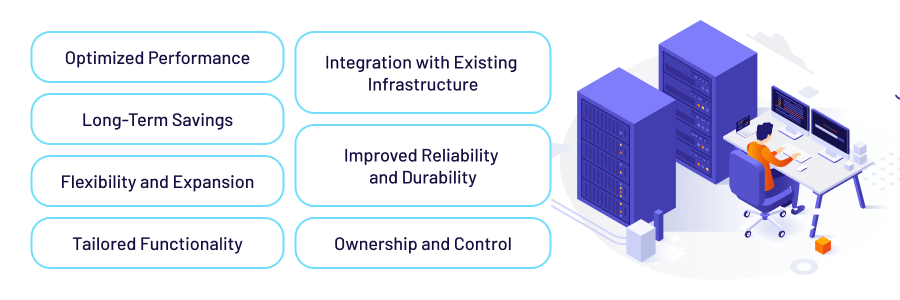
Custom IoT hardware offers several advantages over off-the-shelf solutions, especially when tailored to specific use cases, industries, or requirements.
These include:
Optimized Performance. Custom hardware can be designed with specific performance requirements in mind, tailored to the exact needs of the application. By selecting the right components, processors, sensors, and communication modules, developers can optimize the device’s performance for speed, accuracy, and efficiency.
Long-Term Savings. While the initial development cost of custom IoT hardware may be higher, it can lead to long-term cost savings. It allows for the elimination of unnecessary features and elements, reducing the overall bill of materials (BOM) cost.
Flexibility and Expansion. The flexibility of custom hardware enhances customization based on evolving business needs, industry requirements, or technological advancements. As the IoT infrastructure grows, the components can scale accordingly to prevent costs associated with total system overhauls due to outdated or low-capacity parts.
Tailored Functionality. It means that you have only the features needed for the application, no more, no less. Developers can incorporate specialized sensors, actuators, or communication protocols that are not available in off-the-shelf devices. Tailored functionality allows for the creation of unique, innovative IoT solutions that differentiate businesses in the market.
Integration with Existing Infrastructure. The hardware’s design aims at seamlessly integrating with existing systems, software, and networks within an organization. Compatibility with legacy systems or proprietary software can be ensured, minimizing disruptions and simplifying deployment. Integration with cloud platforms, data analytics tools, and enterprise software becomes more straightforward with custom hardware.
Improved Reliability and Durability. Custom IoT platforms can be built using high-quality components and rugged designs suitable for harsh environments or industrial settings. Reliability testing and quality assurance can be tailored to the specific requirements of the application, ensuring consistent performance. With longevity and durability prioritized, the risk of device failures and maintenance needs is minimized.
Ownership and Control. Organizations have full ownership and control over custom IoT hardware, allowing them to dictate the roadmap for updates, upgrades, and maintenance. Custom devices are not subject to the limitations or dependencies of third-party vendors, giving businesses greater autonomy. Intellectual property rights are retained, protecting proprietary technologies and innovations developed as part of the hardware design.
In short, custom IoT hardware allows organizations to create unique, differentiated products or services that stand out in the market. Tailoring devices to specific customer needs or niche markets can lead to a competitive edge and increased market share.
These advantages provide an attractive option for businesses looking to create tailored, efficient, and innovative IoT solutions that meet their specific needs and requirements. At the same time, the very characteristics that make these so popular may cause damage if the enterprise encounters some of the elements of poor IoT hardware design.
IoT Hardware Design Pitfalls
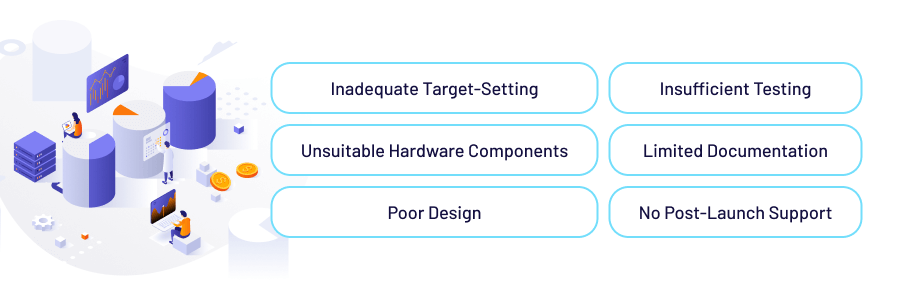
Inadequate Target-Setting. Unclear or changing requirements can lead to a misalignment between the developed hardware and the actual needs of users or stakeholders. If the use cases are not clearly defined, it can result in a lack of focus and direction for the development team. Insufficient understanding of the market, including customer needs, competition, and trends, can lead to developing a product that does not meet market demands.
Unsuitable Components. Selecting inappropriate or unreliable hardware pieces can result in performance issues, compatibility problems, or difficulties in production. It will also be likely to raise maintenance costs down the road and require more testing and iterations, which may overwhelm your budget.
Poor Design. Design flaws in the hardware architecture, layout, or connectivity can lead to inefficiencies, performance bottlenecks, or difficulties in assembly.
Insufficient Testing. Skipping or inadequately performing testing phases can result in undetected bugs, performance issues, or unreliable device behavior.
Limited Documentation. Poor documentation for users, developers, or production teams can bring about difficulties in setup, maintenance, or troubleshooting. As with building software, clear guidelines and documentation are essential at all development stages.
No Post-Launch Support. Neglecting post-launch support, updates, or maintenance can result in unresolved issues, missed opportunities for improvement, and lower user satisfaction. This, in turn, may decrease the market share of your product or even cause it to fail altogether.
To mitigate these risks and ensure successful project implementation, it’s crucial to plan ahead and continuously improve products throughout the development lifecycle.
Embracing Hardware for Business
Virtually every industry can reap the benefits of introducing IoT hardware into their business processes due to the high adaptability, scalability, and efficiency of these solutions. The question is how to achieve that.
Here’s our Ultimate To-Do List to Launch a Successful IoT Project
We at Velvetech have been leveraging our expertise in IoT hardware engineering to offer services and competitive solutions that ensure our clients’ success. Get in touch to start the conversation right now.










